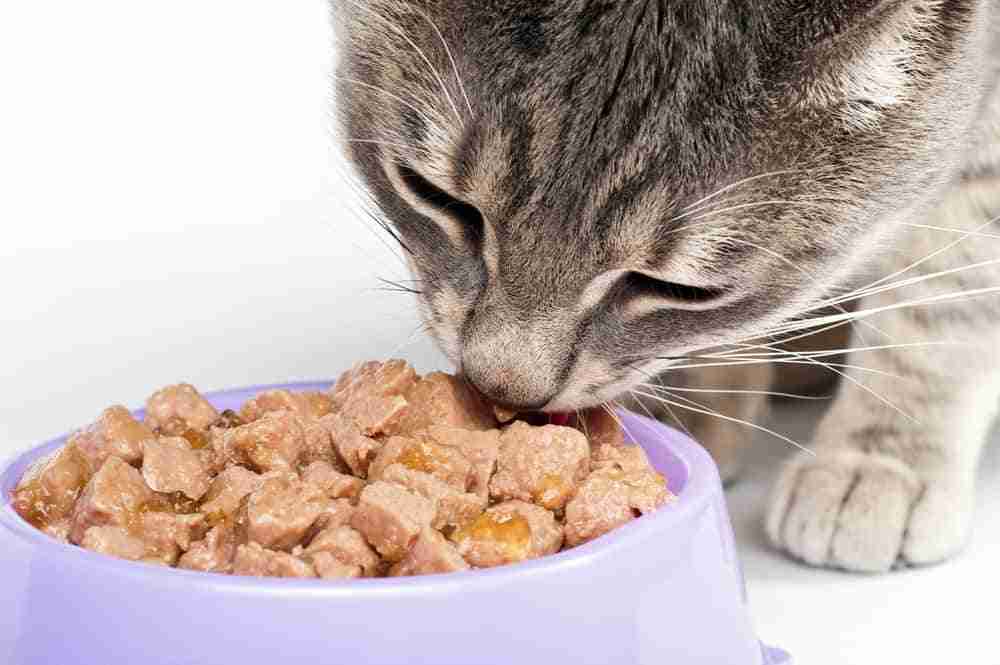If your cat throws up after eating wet food it can be worrying. We have all heard how good wet food is meant to be for cats, so why would your cat be throwing up after eating it? Well, assuming your cat does not have a big health problem the most likely answer is that either the food has gone bad, your cat is eating too quickly or your cat has a food sensitivity.
Let’s have a look in more detail and see what can be done about this peculiar, but common problem, and identify when it is time to worry!
Why Does Cat Throw Up After Eating Wet Food
If your cat throws up immediately after eating wet food but doesn’t seem to have a problem with dry food or treats and doesn’t appear to have any serious health issues that you know about then the chances are that they are most likely eating too quickly, have a sensitivity to some ingredients in the wet food or the food has gone bad.
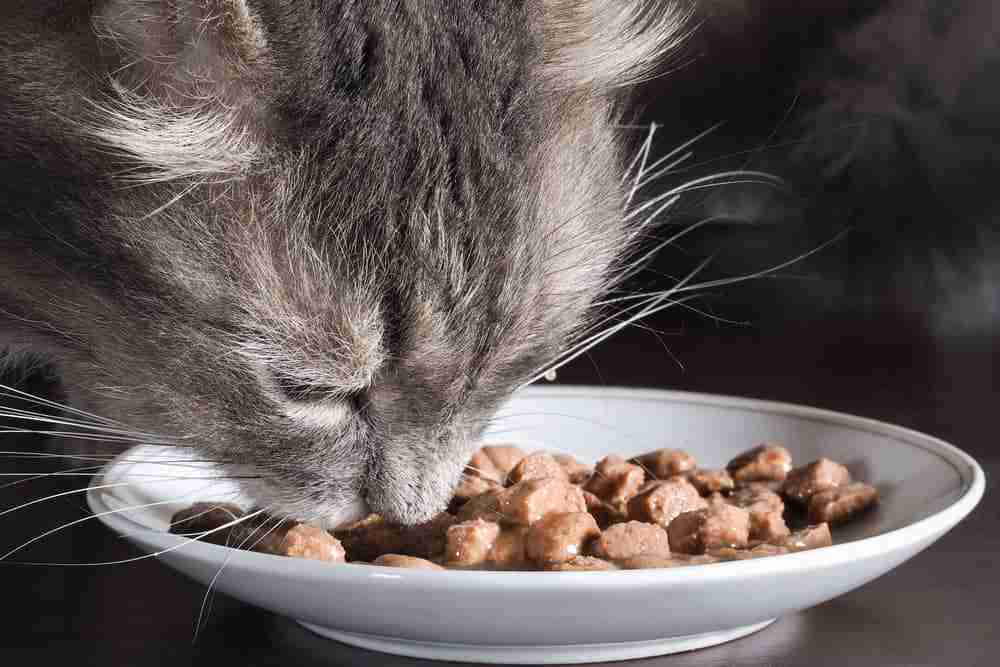
Eating To Quickly
Your cat could be eating too quickly for a number of reasons. They may just really like the flavor and aroma of the food and simply can’t get enough of it! Everyone, who enjoys their food finds it easy to eat fast and your cat is the same – they are thoroughly enjoying it!
But, there could be other reasons that your cat eats quickly. Your cat might feel they may lose out if they don’t finish up quickly. This is often an issue if they live in a home with other cats or dogs. The fear of loss of food supply might be motivating them to eat fast.
The food bowl might be located in an area your cat feels vulnerable. If the food bowl is placed near a door or in a busy thoroughfare the cat might be aware it could be disturbed at any moment or attacked. Your cat may feel vulnerable crouched over the food bowl where it has been placed and decide that speed is of the essence here. Get in and get out fast!
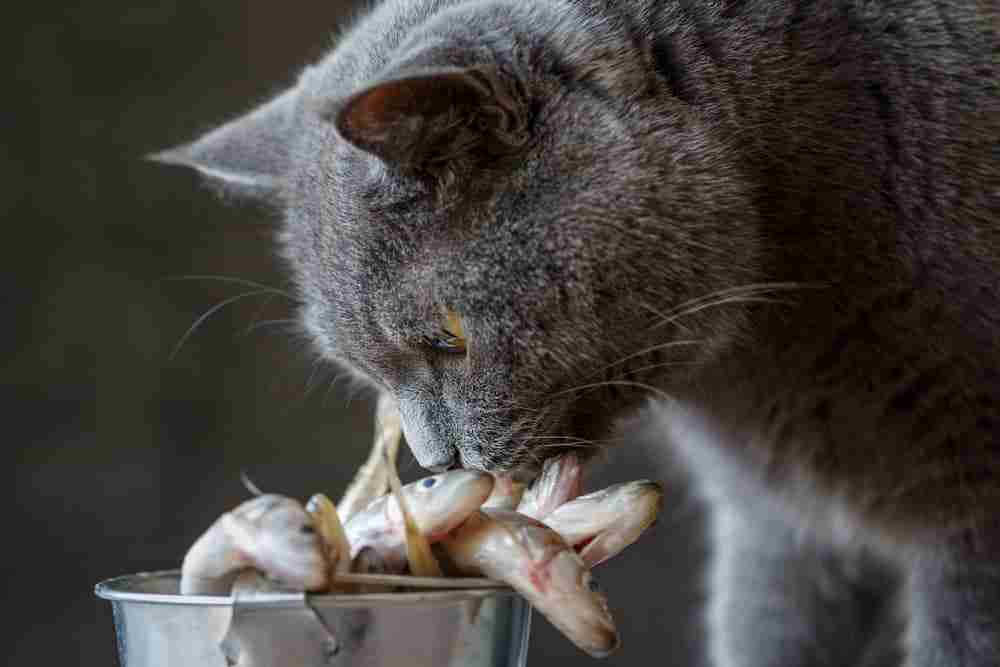
Food Sensitivities
Something we don’t often consider is that cats can get sensitive to ingredients in food. Sensitivity to food ingredients can develop gradually over time – making it very hard to identify a problem food, or it could be an instant reaction to something that simply disagrees with their digestive system – making it easy to avoid that food brand/recipe in the future.
Ingredients that often cause a problem can be carbohydrate-based ingredients that cats simply don’t really expect to encounter naturally, to preservatives and flavorings added to enhance or protect shelf life. Surprisingly, some cats can be sensitive to proteins in chicken and fish! And then you get cats that have a problem digesting rich darker meats like beef or venison.
In the age of manufactured and processed foods where we tend to feed our cats their “favorite” dish very regularly, food sensitivity can be a common issue.
One thing that can help identify sensitivities is that they tend to include more than one symptom. Your cat is likely to suffer from gas, loose stools, and bloating with sensitivity – although it is possible that simply vomiting is the only clue you will get!
Spoiled Food
Your cat could be vomiting because the food they are eating has spoiled. Now, this is unlikely to be a common problem and your cat is unlikely to encounter this issue more than once.
Most wet food can be stored for a very long time without issue. Canning and air-tight packaging mean that foods can last for longer than a year if unopened. Additionally, neither you nor the retailer is likely to keep stocks for years – most just order on delivery as needed basis.
But it is still a possibility.
How To Stop My Cat From Throwing Up After Eating Wet Food
So what can we do to stop our cats from throwing up after eating wet cat food? Let’s take a look at the options for fast eaters and cats with food intolerances.
Slow Down Fast Eaters
To eliminate vomiting due to fast eating and potentially overeating there are a few tactics that can be deployed to sow your cat down.
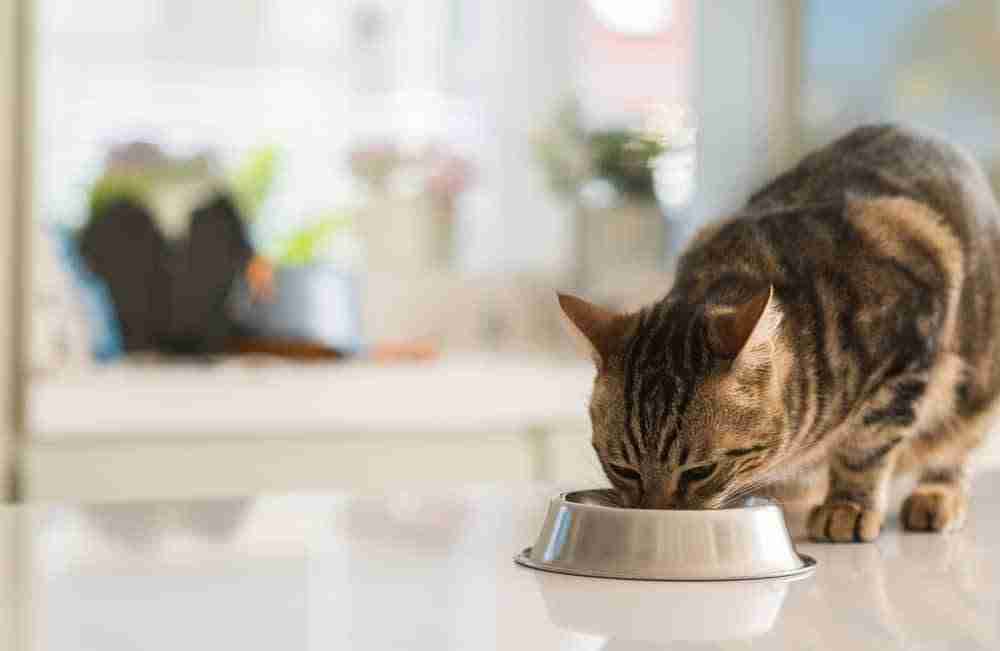
Slow Eating Bowls
The first option is to get a slow-eating bowl. These are usually ceramic or plastic bowls with an uneven, hedgehog-style surface that you push the wet cat food into. The idea is that the cat has difficulty lifting food from the bowl in one sitting and has to constantly reposition to get access and then, only get a small amount at any one time. The net effect is that the actual meal is slowed down. It may take your cat twice as long to eat the same food.
An even more complex feeder designed to slow down your cat and mentally stimulate them is the puzzle feeder. These food dispensers require your cat to figure out access – often the need to dip a paw in an opening to get some food!
If all this sounds like too much trouble you could simply put a golf ball in their food bowl. The golf ball will make eating just that little bit harder and force them to move around the bowl for access – meaning they take longer to eat the same meal!
Smaller Meals More Regularly
If speed is the problem leading your cat to overeat and regurgitate, then a steady supply of smaller meals more often could be the way forward. Distinctly less convenient for the cat guardian than a slow-eating bowl, feeding smaller meals spaced out throughout the day may give your cat more time to digest their food and avoid overeating.
Additionally, the constant supply of food, even in small quantities, may address any food availability issues causing them to eat quickly. Rehomed cats that have lived some of life as stray can suffer from food supply anxiety and eat fast whilst food is available. If they come to learn that food is regularly available it may slow them down!
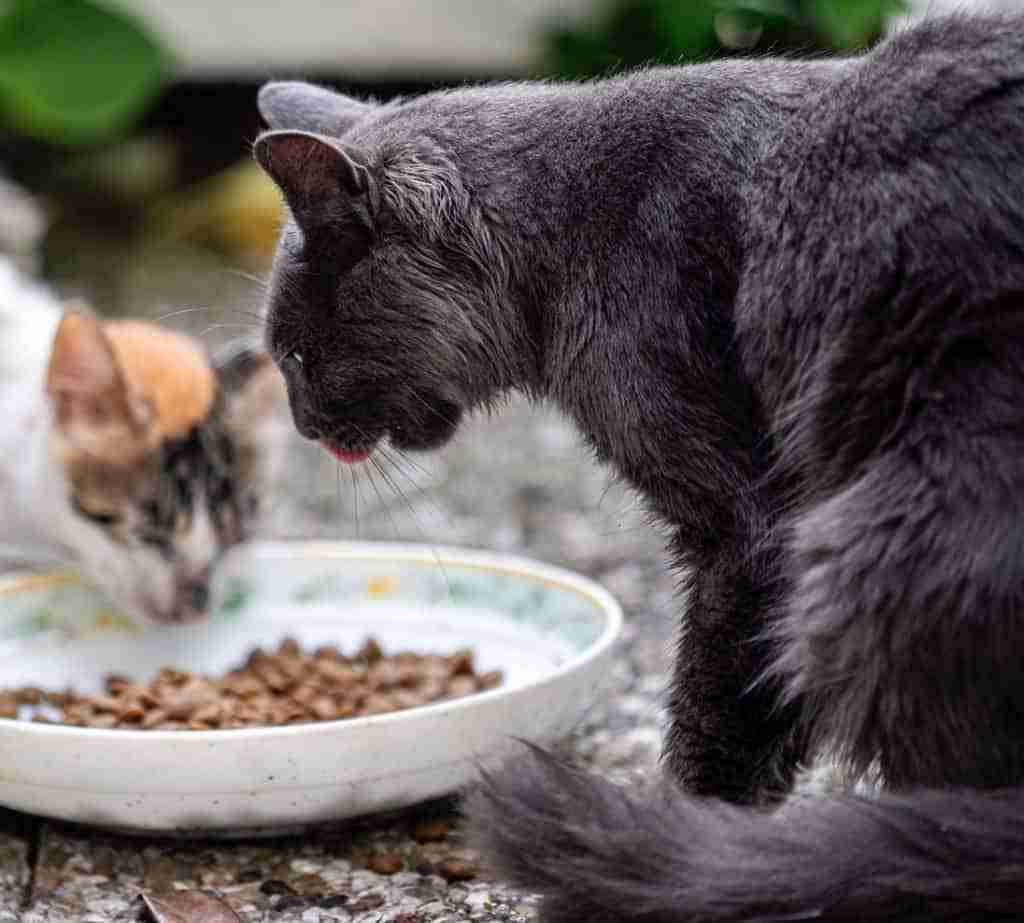
Separate Cat Feeding Stations In Multi-Cat Homes
If you have several cats they may be competing with each other for food and overeating and eating too quickly in response to each other.
In this scenario, it might be smart to feed each cat separately – almost as if you would do it if you were introducing a new cat to the home. Separate eating areas out of sight of each other may lead to a normalized eating situation where each cat does not feel the pressure to eat its fair share before they are potentially pushed out the way by a more dominant cat.
Change Feeding Location
Your cat could be eating quickly and then vomiting because the food bowl is located in an area that makes the cat feel vulnerable.
If the bowl is near a door to the outdoors they may have seen other cats in the yard and feel anxious when eating, fearing an attack. This could result in them eating quickly and vomiting as a result.
If the bowl is in a walkway they may feel vulnerable to unexpected disturbance with the same effects.
Changing the food bowl location may be enough to get them to slow down and avoid vomiting as a result.
Change Out Food
If eating speed is not the problem your cat might have developed a food intolerance. These can be difficult to isolate and identify. If your cat has been eating the same brand and recipe for some time you might completely miss the identification of the food intolerance, assuming the cat loves its favorite food. But, sometimes these intolerances develop after prolonged exposure.
The first option is to change out the brand in its entirety in case it is a specific ingredient a single manufacturer uses. Then look to alter food types – go from fish to chicken or turkey or the like to eliminate a problem with a meat type.
Unfortunately with food intolerances, the situation is very much a process of elimination to try to identify the problem food.
Take a look at some of our advice here and some of the food options. They might help you if you identify that your cat has an intolerance.
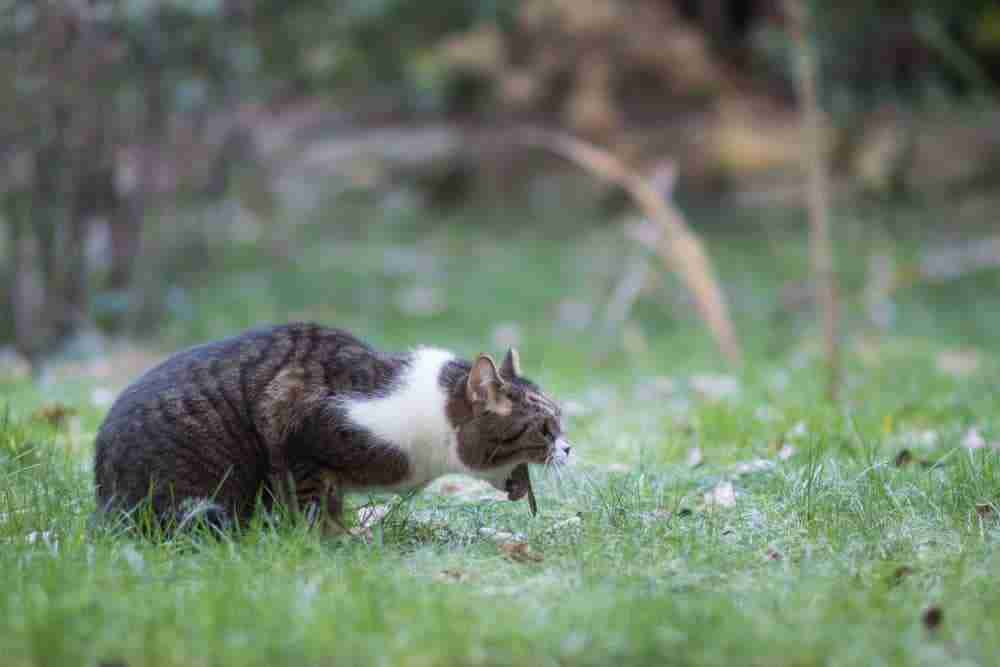
Vomiting in Cats – When To Worry
You may be concerned that your cat is vomiting after eating wet food. After all, it can be a sign of more serious issues.
When is vomiting just a little bit of regurgitating overeaten food and when should you actually call a vet?
Strictly speaking, if your cat has vomiting that is ongoing for a 24-hour period and has been unable to keep anything down, including water, then this is an issue that needs addressing by a vet.
If your cat suffers from other symptoms including loss of appetite, diarrhea, unusual lethargy, pale gums, drinking or peeing more often, blood spot in vomit, or has eaten something they shouldn’t – then get your cat to a vet for an examination.
Regurgitating a part of a meal, even if a relatively regular occurrence, is not uncommon in cats – their digestive system is ultimately horizontal to the floor so more likely to spill occasionally – but being unable to keep anything down at all even if not accompanied by other symptoms is very dangerous for your cat and needs resolving at the earliest opportunity!
